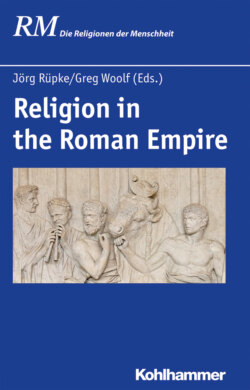Читать книгу Religion in the Roman Empire - Группа авторов - Страница 19
На сайте Литреса книга снята с продажи.
5 Empire and Religions
ОглавлениеMani provides an example of a kind of religious entrepreneurism that became more common, or at least more successful in terms of attracting adherents, over the first centuries AD.
Earlier religious innovators certainly existed. It is difficult to imagine any other origin for the cult of Mithras as we know it in the Roman West, apart from a single invention by a founding group.54 That group had some knowledge of Iranian and Syrian traditions about the god that we can trace back to the Bronze Age via the Achaemenid Empire. They also knew something about Greek mystery cults, and their central rituals seem to have been formed in dialogue with Roman ritual traditions. At some point, probably in the late first century AD, a new synthesis was created with a new iconography and temple form and it was widely imitated or disseminated throughout the west before local variants appeared and the cult became less and less distinctive. Roman Mithras had some unusual features—apparently worshipped mainly by men for example—but he did not demand exclusive adherence, and relationships were established with other deities over time. Why no founder’s name was attached to this is impossible to say.
From the first century AD a new series of religious movements appear which did stress the identity of their founder, tended to make use of sacred texts, and tended to demand exclusive adherence and to claim uniquely accurate knowledge of the cosmos (as opposed to authoritative knowledge about how to perform particular rituals). Rabbinical Judaism, Christianity, Manichaeism and Islam were the most successful but there were others as well, and Sassanian period Zoroastrianism could be considered alongside them.55 It is reasonable to ask how far they were shaped by developing in a world dominated by empires.56 A range of suggestions can be made. As has already been observed empires tend to foster networks of cities, facilitate movement and communication of various kinds, and often nurture diasporas within them. Diaspora is a perfect incubator of religious identity, since common beliefs and rites are one means by which populations distinguish themselves from their neighbours.
The transformations of Isis from Egyptian through Greek and Roman versions provides one example of the generalization or universalization of previous local religions.57 A Bronze Age deity who occupied an important place in the Egyptian myth of the death of Osiris was identified probably during the Persian period with the Greek goddess Demeter and in the last centuries BC worshipped by Egyptians in the Aegean world and Greeks in Egypt. Associated with many other powerful female deities, and given a Greek iconography she gradually became popular in Sicily, southern Italy and eventually in Rome from where she moved north of the Alps. By the first century AD she was mostly accompanied just by Serapis (a new version of Osiris) and her baby son Harpocrates (once Egyptian Horus) and had new roles not just in initiation rituals modelled on Greek mystery cults but also as a goddess of sailors. The navigium Isidis, a ceremony opening the sailing season each year, was celebrated in port cities in the west and eastern Mediterranean basins during the early empire.
Some other features of imperial rule may have played a part. Most empires have relied on writing and written law or edict. The kind of sacred texts used by emergent religions were not very like those issued by emperors but they shared in (or challenged) their authority. Imperial messages were sometimes entitled sacrae litterae and imperial and religious documents were often inscribed in monumental inscriptions from the Achaemenid period onwards. Finally there were the grandiose universalisms created by many early empires.58 Perhaps earthly empire, with its great symbolic production of maps and globes, geographies and astrologies, and all those divine emperors, helped create a space for more grandiose cosmologies. It seems unlikely that a new species of entrepreneurs appeared in this period, and more likely that their ideas found more fertile ground among the subjects of earthly empires. In the long run, the religions they helped create, long outlasted the empires of Eurasian antiquity.
